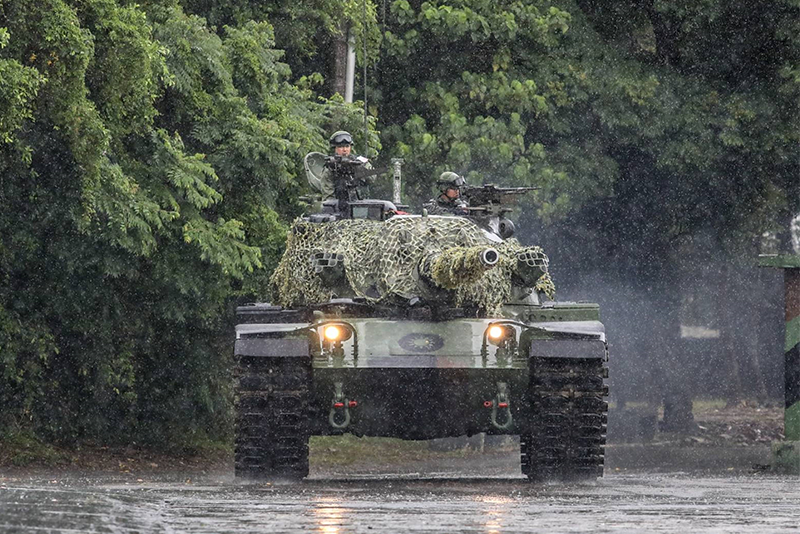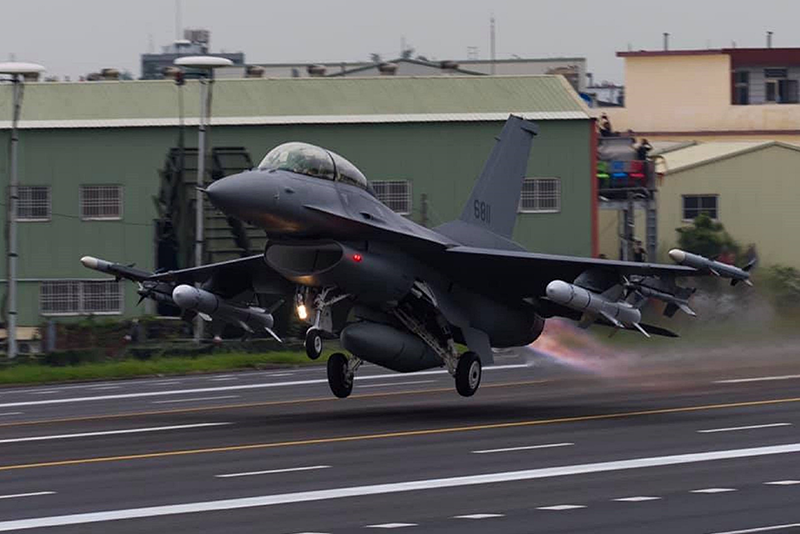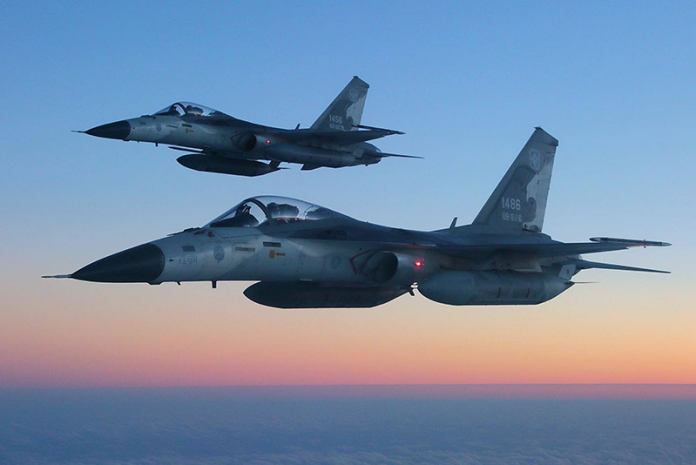Taiwan’s force modernisation still short of international buy-in so indigenous development and manufacturing remain’s vital.
Tensions between the People’s Republic of China (PRC, or China) and the Republic of China (RoC, or Taiwan) – which claims the latter as a part of its territory and seeks to achieve eventual unification, by force if necessary – has never been this pronounced since the Taiwan Strait Crisis of 1996.
Although China had for decades been seemingly content to maintain an uneasy status quo with Taiwan, military encounters between their armed forces have been steadily growing in recent years given the rapid modernisation of the People’s Liberation Army (PLA) and the growing frequency and complexity of its military exercises around the Taiwan Strait. In March this year, two PLA Air Force (PLAAF) J-11 combat aircraft crossed the de facto ‘median line’ over the waters that separate Taiwan from the mainland, prompting a scramble by the island’s own air force to shadow the intruding aircraft.
The military exercises are only part of China’s multi-pronged efforts to tighten its noose on Taiwan, which has also seen Beijing wield its growing diplomatic and economic clout to pressure global industry to cease references to Taiwan as a nation, as well as convince governments to sever their diplomatic ties with Taipei.
The uncertain security environment has spurred Taiwan president Tsai Ing-wen’s administration to increase defence spending in 2019 to $11 billion (NT346 billion), a 5.6 percent ($600 million) increase over expenditure in 2018. According to Ministry of National Defense (MND) spokesperson Chen Chung-chi, the government plans to incrementally increase the military budget to $13.6 billion (NT$421.8 billionn) by 2029.
With only rare exceptions, Taiwan’s acquisition of weapon systems has long been limited to the United States as Chinese pressure has deterred many countries and suppliers from even considering the sale of military equipment or technology to the island. However, this has instead instilled a strong sense of self-reliance that has nurtured robust indigenous defence research and development (R&D) and manufacturing capabilities.
“Generally, insufficient investment since the mid-2000 has resulted in poor lifespan management within the three services,” Dr Wu Shang-Su, a research fellow specialising in regional security, told AMR. “Among them, the army would suffer most, the air force least, and the navy in the middle.”
“The current efforts in defence modernisation reflects the [current state of] strategic planning, layered defence, or in the previous phase: air defence, sea denial and anti-landing,” he added. “Thus, the air force and navy enjoy the great deal of investment [in recent years].”
Regarding the threats, Taipei’s defence investment is insufficient. Although Taiwan has a sluggish economy, some governmental expenditures, such as some social welfare and infrastructure, could be reallocated to defence.
Army modernisation
According to the 2017 edition of the National Defense Report (NDR), the Republic of China Army’s (RoCA) core peacetime roles include protecting Taiwan’s main island and its outlying islands by building basic warfighting and contingency response capabilities, carrying out contingency operations, and securing critical infrastructure. The army also supports anti-terrorism operations and proactively assists with local disaster prevention and relief when required.
Disaster relief is also a priority mission of the army during peacetime as Taiwan is regularly hit by natural disasters such as earthquakes, floods and typhoons. This requires the service to be able to mobilise quickly to offer aid to affected areas and work closely with civilian agencies.
Approximately 80 percent of the RoCA’s manpower is positioned on the main island, with the remainder on the outlying islands to respond to wartime contingencies. The NDR stipulates that the army must be able to swiftly integrate with other services operations in a “mobile, speedy, and decisive” fashion and to repel an invasion force by methods such as mounting beachhead assaults and counter-airborne operations.
The service maintains around 400 CM-11 Brave Tiger and 300 M60A3 Tank Thermal Sight (TTS) main battle tanks (MBTs). The CM-11 MBT is a hybrid design – comprising a modified M48 turret mounted on a standard M60A3 chassis and equipped with a fire control system (FCS) that is comparable to that of the General Dynamics M1A1 Abrams platform – developed by Taiwan’s Armoured Vehicle Development Center with assistance from General Dynamics’ Land Systems Division.
In October 2017 the MND announced that it would explore the possibility of upgrading the army’s M60A3 TTS fleet and allocated almost $6.6 million to the state-owned National Chung-Shan Institute of Science and Technology (NCSIST) to lead R&D work including the integration of a 120mm calibre main gun, as well as updates to the ballistic FCS and turret hydraulic system. Two MBTs have been assigned to the agency for use as prototypes and are expected to be ready by the end of 2019, ahead of upgrade work commencing in 2020. There is also an interest to upgrade the CM-11/12 MBT fleet, although the growth potential of these vehicles will be limited given their age.

However, the planned MBT modernisation could be abandoned if the MND’s request to procure 108 M1A2 tanks along with an assortment of missile systems – comprising 250 Raytheon FIM-92 Stinger surface-to-air missiles, 409 Raytheon-Lockheed Martin FGM-148 Javelin and 1,240 Raytheon BGM-71 TOW anti-tank missiles – under a $2bn arms package. The ministry confirmed on 6 June that it had already submitted a formal request to the US government and that that the sales process is progressing as anticipated. If successfully acquired, these MBTs are expected to equip two armour battalions in northern Taiwan.
The army is also moving forward with plans to replace its ageing M113 and CM-21 tracked and wheeled V-150 armoured personnel carriers (APCs) to improve the mobility, firepower and survivability of its mechanised infantry brigades. The indigenously developed and built 8×8 CM32/CM33 Yunpao (Clouded Leopard) was selected in 2010 as the replacement under a programme estimated to be worth at least $1.8bn (NT$58bn).
A total of 1,400 CM-33 APC and CM-32 command variants of the Clouded Leopard had originally been envisaged, although production figures were subsequently cut. Several technical defects were also discovered during early production runs – including cracks in vehicle armour plates – although the MND announced in March 2010 that these problems had been resolved and series production of the first tranche of up to 652 vehicles was to begin by November, with an initial contract for 368 vehicles being filled by 2018.
A new infantry fighting vehicle (IFV) variant armed with a turreted Orbital ATK 30mm Mk44 Bushmaster II automatic cannon is reportedly entering production in 2020 with up to 284 of these expected to be delivered by 2023. The MND announced a $112 million contract for 285 30mm Mk44 Bushmaster II cannons on 29 September 2017.
Navy modernisation
The Republic of China Navy (RoCN) is responsible for the protection of Taiwan’s sea lines of communication as well as control and surveillance of its surrounding waters. The service’s principal combatants include four Keelung-class (ex-US Navy Kidd-class) destroyers equipped with the New Threat Upgrade combat system, which offer a significantly enhanced anti-air capability, as well as several types of frigates.
The newest of these are the six 3,800 tonne Kang Ding platforms derived from the French La Fayette-class design, which are primarily configured for anti-surface and anti-submarine warfare (ASuW and ASW) with the Hsiung Feng II (Brave Wind II, or HF-II) anti-ship missiles (ASMs) and Mk46 torpedoes.
The ten 3,000 tonne Chi Yang-class frigates (former US Navy Knox-class frigates) feature an enhanced air defence capability with the integration of the Standard Missile-1 (SM-1) surface-to-air missile (SAM) along with an improved air surveillance radar, as well as the H-930 modular combat system (MCS), enabling the vessels to engage newer generation Chinese aircraft.
Under the broader tri-service Po Sheng (Broad Victory) upgrade programme, the RoCN’s eight 2,800 tonne Cheng Kung-class frigates have been upgraded with the latest HF-III ASMs, enhanced C4ISR systems and new Link 16 tactical datalink multifunctional information distribution systems (MIDSs) designed to provide secure high capacity voice and data communications.
However, understanding the futility of standing toe-to-toe with the far better-equipped PLA Navy (PLAN) surface fleet, the RoCN has invested in high-end asymmetric capabilities centred on its fleet of high-speed stealth missile corvettes and attack craft. The MND has commissioned local shipbuilder Lung Teh to construct the first production batch of three Tuo Jiang-class missile corvettes, which will be better equipped and armed than the first-of-class prototype constructed in 2012 and commissioned into service in 2015. These would carry a ‘high-low’ mix of HF-IIF and HF-III ASMs that would be launched in salvos against high-value PLAN targets such as aircraft carriers and amphibious assault ships, with both types of missiles adopting distinct flight profiles to confuse ship point defence systems. Another seven Tuo Jiang corvettes are planned following the delivery of the third vessel in 2025.

The service has also fielded several squadrons of Kuang Hua VI (KH-6) guided missile craft that have been armed with HF-II ASMs. These stealthy boats are primarily configured as hit-and-run platforms and are not equipped with surface or air surveillance radars to maintain their low observability characteristics. Instead, they rely on targeting data supplied via datalink by shore-based sensors or other friendly surface combatants.
The MND has also awarded a contract to CSBC Corporation to build the first of four projected 16,000 tonne amphibious assault ships that will be able to carry over 500 troops and up to two utility landing crafts (LCUs) or four 16m mechanised landing crafts (LCMs) in its well dock. It will also feature a flight deck that can accommodate a medium-lift helicopter. Besides point defence weapons, the new assault ships will reportedly be equipped with HF ASM launchers.
Meanwhile, the RoCN’s perennially delayed plan to field a new generation of indigenous diesel-electric submarines to replace its ageing Dutch-built Hai Lung (Sea Dragon)-class boats and Guppy II/Hai Shih (Sea Lion)-class submarines has advanced considerably with work on a dedicated submarine production facility in the southern port of Kaohsiung getting under way in May 2019. The new centre will be operated by CSBC’s Submarine Development Centre and expected to be functional by 2020. The MND awarded a contract in 2017 to CSBC and NCSIST to design and build between six and eight submarines.
Taiwan defence minister Yen De-fa told media in March 2019 that the “contract design phase” of the submarine effort had been completed and that the government expected the construction of the first submarine – reportedly displacing up to 3,000 tonnes with an overall length of 70m and a beam of 8m – to be completed by the mid-2020s.
Air force modernisation
The Republic of China Air Force (RoCAF) is widely regarded as Taiwan’s premier military asset, which has for decades offered a technological superiority over the PLAAF’s legacy combat aircraft and bomber fleet.
However, this advantage has been eroded by potent fourth- and fifth-generation Chinese combat aircraft such as the indigenous J-10, J-11, and J-20 that are also augmented with Russian-made Su-30s and Su-35s. The PLAAF is also fielding increasingly capable beyond-visual range air-to-air missiles (BVRAAMs) such as the PL-12 and PL-15.
The RoCAF is also facing the prospect of a reduced fighter inventory from 2020, when its ageing Northrop Grumman F-5E/F and Dassault Mirage 2000-5 aircraft are progressively retired due to increasing maintenance costs.
The MND has attempted to bolster its Lockheed Martin F-16A/B fleet with up to 66 F-16C/D Block 52 aircraft from the United States since 2006. However, Washington declined to approve the request in September 2011 and instead struck a deal to upgrade the RoCAF’s existing F-16A/Bs to the latest F-16V configuration, which features the Northrop Grumman AN/APG-83 active electronically scanned array (AESA) radar derived from the F-18E/F Block 60 AN/APG-80 system, a new Raytheon mission computer, the Link 16 datalink, updated cockpit displays, an enhanced electronic warfare (EW) system, and a ground collision avoidance system.

Lockheed Martin was awarded a $272 million contract to install 142 F-16V aircraft upgrade kits acquired under a separate $1.85 billion deal, with upgrade work in Taiwan and in the United States to be completed by May 2022. Taiwan’s Aerospace Industrial Development Corporation (AIDC) has constructed a dedicated hangar at Taichung that can modify up to 24 aircraft annually. One of the first updated examples made its public debut at an alternate runway launch and recovery exercise during Taiwan’s annual Han Kuang military exercise, which simulates a Chinese invasion.
The AIDC has also developed and manufactured the RoCAF’s F-CK-1 Ching Kuo Indigenous Defense Fighter (IDF), which entered service in 1994 and has benefited from considerable upgrades – including the improved GD-53 radar, digital cockpit displays, 32-bit digital flight control computer (DFLCC), as well as dorsally mounted conformal fuel tanks (CFT) – between 2009 and 2017. The upgraded fighters are designated F-CK-1C and F-CK-1D and also feature additional payload capacity. For example, they can now carry four Tien Chien II AAMs as opposed to two previously.
by JR Ng













